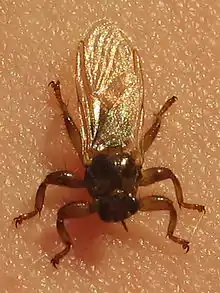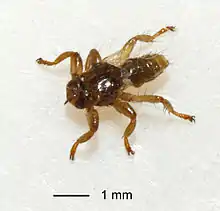Lipoptena cervi
Lipoptena cervi, the deer ked or deer fly, is a species of biting fly in the family of louse flies, Hippoboscidae. These flies are commonly encountered in temperate areas of Europe, Siberia, and northern China. They have been introduced to North America.[2] They are parasites of elk, deer, and other deer family members, burrowing through the fur and sucking the blood of the host animals. Adults are only 5–7 mm (0.20–0.28 in) in length and brownish in colour. Their bodies are flat and elastic, making their removal difficult. L. cervi is a poor flier and can only fly for short distances. Once the insect reaches its target, it sheds its wings and starts burrowing through the fur.
| Lipoptena cervi | |
|---|---|
 | |
| Lipoptena cervi, with wings | |
| Scientific classification | |
| Kingdom: | |
| Phylum: | |
| Class: | |
| Order: | |
| Family: | |
| Genus: | |
| Species: | L. cervi |
| Binomial name | |
| Lipoptena cervi | |
| Synonyms | |
Bite

Although their life cycle depends on deer, they may on rare occasions bite humans, producing responses ranging from unnoticeable to highly allergic. Initially, the bite may be barely noticeable and leaves little or no trace. Within 3 days, the site may develop into a hard, reddened welt. The accompanying itch is intense and typically lasts 14 to 20 days. Occasionally, an itch papule may persist for up to a year.[3] The main annoyance in humans is the inconvenience and unpleasantness of removing keds from hair and clothes.
Anaplasma phagocytophilum, a Gram-negative, obligately intracellular bacterium that causes anaplasmosis, has been detected in L. cervi, as has Borrelia burgdorferi, the causative agent of Lyme disease,[4] but whether the insect can serve as a vector is as yet unknown.
Horses can develop colic after a bite.[5] Dogs that are bitten may develop a moderate to severe dermatitis.[5] And L. cervi can carry and spread Bartonella schoenbuchensis in deer.[3] Much, however, remains unknown about the ked's potential to pose a medical or veterinary threat.
Remains of L. cervi have been found on Ötzi, the Stone Age mummy from the Schnalstal glacier in South Tyrol.[6]
Life history
Both males and females of L. cervi consume blood from their hosts. Feeding lasts 15 to 25 minutes.[3] The female produces one larva at a time and retains the developing larva in her body until it is ready to pupate. The larva feeds on the secretions of a "milk gland" in the uterus of its mother. The female gives birth to a fully mature white prepupa. She may produce larvae for as long as 10 months. A newborn prepupa immediately darkens, forms the puparium, and begins to pupate on the forest floor, or where the deer are bedded. After pupation, the winged adult emerges and flies in search of a host. Upon finding a host, the adult fly breaks off its wings and it is permanently associated with its host.[7]
Distribution
This species is found in most of Europe, including Great Britain (but not Ireland), as well as Algeria, eastern Siberia, and northern China. It was introduced to and is established in the Eastern United States (New Hampshire, Massachusetts, Pennsylvania, Idaho, and New York).[8] It also spread to Finland from Russia in the early 1960s, where it primarily feeds on moose, though it is spreading to reindeer.[7][9][10]
Hosts
Red deer, moose, roe deer, fallow deer, and Siberian musk deer are this fly's native host. In the United States, it has acquired hosts such as elk, white-tailed deer, and reindeer.[7][8] There are stray records of bites on humans, dogs[11] and badger, and it will occasionally commit to the wrong host.[10]
See also
References
- Dick, C. W. (2006). "Checklist of World Hippoboscidae (Diptera: Hippoboscoidea)". Chicago: Department of Zoology, Field Museum of Natural History: 1–7. Cite journal requires
|journal=(help) - Fact Sheets. Deer Keds. Department of Entomology, Pennsylvania State University. Retrieved 2015-09-26.
- Christoph Dehio; Ursula Sauder; and Rosemarie Hiestand (2004). "Isolation of Bartonella schoenbuchensis from Lipoptena cervi, a Blood-Sucking Arthropod Causing Deer Ked Dermatitis". Journal of Clinical Microbiology. US: American Society for Microbiology. 42 (11): 5320–5323. doi:10.1128/JCM.42.11.5320-5323.2004. ISSN 0095-1137. PMC 525279. PMID 15528732.
- Buss B, Kearnery C.B., Coleman, C., Henning, J.D. (December 2016). "Detection of Lyme disease and anaplasmosis pathogens via PCR in Pennsylvania deer ked." Journal of Vector Ecology 41 (2): 292-294.
- Jonas Malmsten in Sauli Härkönen (Editor) (2007). The Scandinavian deer ked situation from a veterinary medical perspective. 1st Nordic Workshop on Biology, Applied Importance and Current Research on the Deer Ked, Workshop Schedule and Abstracts. Finland: Finnish Forest Research Institute. p. 22.CS1 maint: extra text: authors list (link)
- Gothe R, Schöl H (1996). "Stone age deerfly (Lipoptena cervi) found with a mummy in a glacier". Tierärztliche Praxis (in German). 24 (6): 549–551.
- Arja Kaitala; Sauli Härkönen; Sauli Laaksonen; Pekka Niemelä; Petteri Nieminen; Hannu Ylönen (2007). Sauli Härkönen (ed.). Deer Ked Project – a broadly-based interdisciplinary research project in Finland. 1st Nordic Workshop on Biology, Applied Importance and Current Research on the Deer Ked, Workshop Schedule and Abstracts. Finland: Finnish Forest Research Institute. p. 22.
- Maa, T. C. (1969). "A Revised Checklist and Concise Host Index of Hippoboscidae (Diptera)". Pacific Insects Monograph. Honolulu: Bishop Museum, Honolulu, Hawaii. 20: 261–299.
- Sauli Laaksonen; Tommi Paakkonen; Raine Kortet; Anne-Mari Mustonen; Petteri Nieminen; Laura Härkönen; Milla Solismaa; Arja Kaitala; Hannu Ylönen; Jari Aho; Sauli Härkönen (2007). Sauli Härkönen (ed.). Deer ked – a threat to reindeer welfare?. 1st Nordic Workshop on Biology, Applied Importance and Current Research on the Deer Ked, Workshop Schedule and Abstracts. Finland: Finnish Forest Research Institute. p. 22.
- Hutson, A.M (1984). Diptera: Keds, flat-flies & bat-flies (Hippoboscidae & Nycteribiidae). Handbooks for the Identification of British Insects. 10. Royal Entomological Society of London. pp. 84 pp.
- Hermosilla, C.; Pantchev, N; Bachmann, R; Bauer, C (2006). "Lipoptena cervi (deer ked) in two naturally infested dogs". Veterinary Record. Great Britain: British Veterinary Association. 159 (9): 286–287. doi:10.1136/vr.159.9.286. ISSN 0042-4900. PMID 16946313.
Notes
11. Egri, B., Rigó, E.(2014): A Hanság gímszarvasainak Lipoptena cervi (Linnaeus, 1758) fertőzöttségéről (Irodalmi összefoglaló és saját megfigyelések)(About the deer ked ((Lipoptena cervi, 1758))infestation on the red deer in Hanság Region. Literature review and own examinations. Magyar Állatorvosok Lapja, 136.2.: 115–122.
External links
 Media related to Liptoptena cervi at Wikimedia Commons
Media related to Liptoptena cervi at Wikimedia Commons